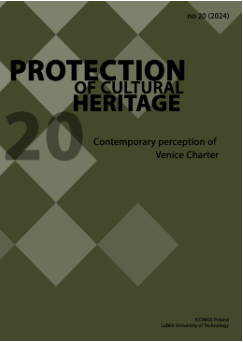VIRTUAL CONSERVATION-RESTORATION VS. ACTUAL CONSERVATION-RESTORATION IN THE CONSERVATION OF FRAGMENTARY ARTEFACTS: THE CASE STUDY FRESCOES FROM SYBARIS - COPIA (ITALY)
Sokol Muca
Higher School of Conservation and Restoration of the Cultural Heritage in Matera (Włochy)
https://orcid.org/0000-0002-6715-5969
Abstrakt
This article discusses the role that new digital technologies play on conservation-restoration of fragmentary artefacts. Above all, the use of these tools is essential in case the artefacts have lost the formal unity and reach us without documentation concerning their original position, as in the case of the Roman frescoes from Sybaris, object of this study. The creation of virtual models proves as fundamental for the material and formal recomposition of the artefacts, especially in the creation of a new support and display choices. This last aspect required an analysis on the effects that virtual reconstructions and augmented reality have on visitors.
Słowa kluczowe:
3D, Augmented Reality, perception, Virtual restoration, Roman frescosBibliografia
Brandi, C. (1963). Teoria del restauro: lezioni raccolte da L. Vlad. Borrelli, J. Raspi Serra, G. Urbani ... Con una bibliografia generale dell’autore. Roma: Edizioni di Storia e letteratura.
Brandi, C. (1977). Teoria del restauro. Torino: Giulio Einaudi Editore - Piccola Biblioteca Einaudi Ns.
Brandi, C. (2005). Theory of Restoration. Edited by Giuseppe Basile and the Istituto Centrale per il Restauro, translated by Cynthia Rockwell. With presentations by Giuliano Urbani, Nicholas Stanley-Price, Caterina Bon Valsassina, with texts by Giuseppe Basile, Paul Philippot, Giulio Carlo Argan, Cesare Brandi. Firenze: Nardini editore.
Cornell, R. M & Schwertmann, U. (1996). The iron oxides: structure, properties, reactions, occurrence, and uses (p. 29 ). New York: WILEY-VCH.
Eastaugh, N., Walsh, V., Chaplin, T. & Siddall, R. (Eds.) (2004). The Pigment Compendium. (p.201). Oxford: Elsevier Butterworth-Heinemann.
Forte, M. & Beltrami, R. (2000). A proposito di virtual Archaeology: disordini, interazioni cognitive virtualitá. In: Archeologia e Calcolatori n. XI, Moscati, P. (Ed.), pp. 273-300.
Forte, M. (2008). Virtual archaeology. Communication in 3D and ecological thinking. In: Beyond Illustration: 2D and 3D Digital Technologies as Tools for Discovery. In: Archaeology, ArcheoPress, Oxford, pp. 20- 34.
Foti, G. (1969, October). L’attività archeologica in Calabria. In: La Magna Grecia nel mondo ellenistico, IX(LIV), Taranto, pp. 166-171.
Gombrich, E. (1982). The Image and the Eye. Further Studies in the Psychology of Pictorial Representation. Oxford: Phaidon.
Guzzo, G. (1971, Sept./Oct.). III campagna di scavi nella piana del Crati. In: Magna Grecia, anno VI, nr. 9-10, Taranto, pp. 21-24.
Guzzo, G. (1972, October). La documentazione archeologica in Calabria. In: Magna Grecia, XII(LIV), Taranto, pp. 341-345.
Limoncelli, M. (2012). Il progetto “Hierapolis Virtuale” esperienze di restauro virtuale e restituzione in 3D. In: D’Andria, R. & Mannino, K. (Eds.). Gli allievi raccontano (pp.247-253). Galatina: Congedo.
Lopez-Menchero Bendicho V. M. & Flores Gutierrez, M. & Vincent, M. L. & Grande Leon, A. (2017). Digital Heritage and Virtual Archaeology: An Approach Through the Framework of International Recommendations. In: E Levy, T (Ed.). Digital Heritage and Virtual Archaeology in the Digital Age: Acquisition, Curation, and Dissemination of Spatial Cultural Heritage Data (p. 594). Murcia: Springer Verlag.
Rossi Pinelli, O. (2005). Verso un’immagine integrale: derestauri e rirestauri nelle esperienza contemporanee. In: Piva. C & Sgarbozza, I. (Eds.). Il corpo dello stile (pp. 119-134). Roma: De Luca Editori d’Arte.
Settis, S. (2002). L’illusione dei beni digitali. In: Bollettino ICR-Nuova serie, N. 5, (pp. 18-20). Firenze: Nardini Editore.
King’s College London (7 Febrary 2009): The London Charter. Retrived from http//www.londoncharter.org
International Forum Of Virtual Archaeology (2011): The Seville Principles. Retrived from http://www.arqueologiavirtual.com/carta
Autorzy
Sokol MucaHigher School of Conservation and Restoration of the Cultural Heritage in Matera Włochy
https://orcid.org/0000-0002-6715-5969
Student at the ISCR, Higher School of Conservation and Restoration of the Cultural Heritage, in Matera, Italy. His Supervisors: Maria Carolina Gaetani, ISCR, Conservator, and Giorgio Sobrà, ISCR, Architect, Director of the Higher School of Conservation and Restoration of the Cultural Heritage, in Matera. The Chief Supervisor is Giovanna De Palma, ISCR, Archaeologis
Statystyki
Abstract views: 365PDF downloads: 226








